Abstract
Our research focuses on the reconstruction of turbidity paleocurrents of the Cilento Group in the Cilento area (southern Apennines, Italy). These deposits were formed in the wedge-top basin above the oceanic Ligurian Accretionary Complex, the early orogenic wedge of the southern Apennines. The Cilento Group succession, whose age ranges between the uppermost Burdigalian and lowermost Tortonian, consists of a thick pile of sandstones, conglomerates, marls and pelites grouped in two formations (Pollica and San Mauro Fms). We retrieved information on the turbidity current directions through sedimentary features such as flute and groove casts, flame structures and ripple marks. The aim of this study is to shed light on the early tectonic evolution of the southern Apennines by reconstructing the geometry of this basin, the source areas that fed it and the paleogeography of the central Mediterranean area in the Miocene. We analyzed 74 sites in both formations and collected 338 measurements of paleocurrent indicators. Because the succession was affected by severe thrusting and folding, every paleocurrent measurement was restored, reinstating the bedding in the horizontal attitude. Results indicate a complex pattern of turbidity current flow directions consistent with a basin model fed by a spectrum of sources, including recycled clasts from the Ligurian Accretionary Complex, Calabria–Peloritani Terrane and the Apennine Platform units and volcaniclastics from the synorogenic volcanoes located in the Sardinia block.
1. Introduction
Wedge-top (or thrust-top) basins form above the active orogenic wedge, and together with foredeep, forebulge and back-bulge depozones, located ahead the thrust front, compose the Foreland Basin System [1]. Wedge-top and foredeep basins are the places where thick piles of sediments accumulate, eroded from the allochthonous thrust sheets and the surrounding rocks, including the overriding and downgoing plates. The detrital modes of foreland basins are primarily influenced by tectonics, climate and eustasy (e.g., [1,2]). The standard stratigraphic succession consists of upward coarsening sequences unconformable onto a deformed basement, frequently sealing tectonic contacts between major thrust sheets [1]. Wedge-top deposits have varying characteristics, with significant lateral facies variations, multiple local unconformities and complex paleogeographic features due to the neighboring topographic reliefs that developed with the advancing front of the fold–thrust belt [1]. Generally, wedge-top basins form in morphological depressions, frequently originating from tectonic structures, like synclines (e.g., [3]) or graben (e.g., [4]). Understanding the stratigraphy and the sedimentary features of the Foreland Basin System is crucial for constructing the tectonic evolution of the orogenic chains. By determining the ages of the deposits in the foredeep basin and the first wedge-top basin, we can estimate when the orogenic pulses occurred [5]. Additionally, studying the detrital modes and their changes over time can provide valuable information about the source areas, aiding in paleogeographic reconstructions. Generally, wedge-top basin deposits are vulnerable to erosion because of their high structural elevation, and usually, they are preserved in post-orogenic structural depressions, such as the Cilento area in the southern Apennines (Figure 1) along the Tyrrhenian side of the orogenic chain. Here, the Cilento Group (CG) deposits [6], the subject of this study, are exposed.
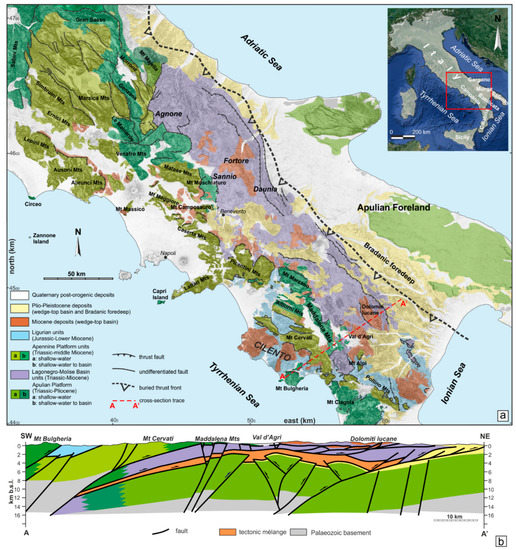
Figure 1.
(a) Geological scheme of the southern Apennines (modified after [5]). The red box in the inset indicates the localization of the geological map with respect to the Italian Peninsula. (b) Geological cross-section (modified after [7]).
The CG is one of the best-preserved wedge-top basin deposits in the southern Apennines, recording the first stages of orogenic construction. It consists of widespread outcrops of turbiditic successions, generally unconformably covering the oceanic Ligurian Accretionary Complex (LAC) formed by the Nord-Calabrese, Parasicilide and Sicilide thrust sheets, including Cretaceous–Lower Miocene successions affected by a complex polyphasic deformation [8,9]. In the southern sector of the southern Apennines (Basilicata region), the CG, at places, covers the Meso–Cenozoic successions of the Apennine Platform domain [10]. The uppermost Burdigalian–lowermost Tortonian CG [6,11,12] is characterized by siliciclastic, calciclastic and volcaniclastic deposits. In the Cilento area [13,14,15,16,17], the CG includes two turbiditic units: (1) the Pollica Fm, encompassing thin beds of siltstones and sandstones at the base, and prevailing sandstones in the middle-upper part; and (2) the San Mauro Fm, formed by sandstones and conglomerates with some characteristic levels of whitish marls (“Fogliarina” Auctt.). In the southern sector of the Cilento area, both formations laterally evolve into coarse clastic deposits, frequently hosting conglomerates (Torrente Bruca facies; [18]). More southward, the CG is replaced by the undifferentiated Albidona Fm, consisting of siliciclastic turbidites with intercalations of calciclastic megaturbidites [6,19,20,21].
The aim of this work is to reconstruct, through the analysis of paleocurrents in the CG turbidites, the geometry of this wedge-top basin and the source areas that fed this basin, shedding light on the early geodynamic evolution of the southern Apennines. Paleocurrent analysis in the Cilento area has already been the objective of several studies in the past few decades [22,23]. However, these works analyzed only a small area of the Cilento, not differentiating the LAC from the wedge-top basin deposits. Hence, in the present study, we analyzed the CG deposits in a broader area of Cilento, reconstructing the original paleocurrent attitudes and analyzing the different formations.
2. Geological Framework
2.1. Regional Geology
The Cilento area is located in the southern Apennines (Figure 1), a segment of the Alpine circum-Mediterranean chains (e.g., [24,25,26,27]). Currently, four first-order geological elements may be distinguished in the central Mediterranean area [28]: (1) the Tyrrhenian Sea, characterized by oceanic and thinned continental crust, representing the back-arc basin developed at the rear of the Apennine–Calabrian Arc system since the Serravallian time; (2) the southern Apennine chain, formed by the superposition of several thrust sheets, including the oceanic (LAC) and platform-to-pelagic basin successions of the Adria Plate of Lower Miocene to Middle Pleistocene in age; (3) the Bradanic foredeep basin, corresponding to the youngest (Pliocene–Pleistocene) flexural depression developed at the front of the thrust belt; and finally (4) the Adriatic–Apulia foreland, constituted of exposed Mesozoic–Tertiary carbonates. The fold-and-thrust belt of the southern Apennines (Figure 1a) consists of a tectonic pile of thrust sheets (Figure 1b) referring to different paleogeographic domains [5,7,8,9,24,25,26,27]: (1) the Ligurian Ocean (2); Apennine Platform; (3) Lagonegro–Molise Basin; and (4) Apulian Platform.
The pre-orogenic stratigraphic architecture of the Adria Plate is made by deposits formed in shallow-water to deep-basin passive margin environments affected by different extensional events [26,29,30]. These include the Late Triassic–Lower Jurassic rifting stage that led to the opening of the Ligurian Ocean and the dismembering of the shallow-water carbonate domain, with the formation of the Apennine and Apulian platforms partially separated by the pelagic Lagonegro–Molise Basin. Subsequently, the Late Cretaceous–Eocene abortive rifting affected these realms, further dismantling the carbonate platforms. According to this pre-orogenic paleogeographic model [5,8,9,20,26], the LAC includes remnants of the Ligurian Ocean (Nord-Calabrese, Parasicilide and Sicilide nappes), which separated the continental part of the Adria Plate (Apennine and Apulian Platform units and the intervening Lagonegro–Molise Basin) from the Europe/Calabria Peloritani Terrane (CPT) [31,32]. The orogenic crustal shortening started with the subduction of the Ligurian lithosphere under the Europe/CPT in the Paleocene/Eocene [5,33], with the complete closure of the Ligurian Ocean in the Early Miocene, and the onset of the LAC formed through frontal accretion of the easternmost oceanic successions. Subsequently, in the Middle-to-Late Miocene, the tectonic prism migrated to the E/NE with the inclusion of several thrust sheets composed of successions belonging to the Apennine Platform and the Lagonegro–Molise Basin. The orogenic stacking of the latter successions was mainly ruled by thin-skinned tectonics characterized by dominant flat-lying thrust faults. Following the docking of the allochthonous wedge with the Apulian Platform in the Early Pliocene, the orogenic wedge superposed onto the Apulian carbonates. After that, the Pliocene–Pleistocene orogenic tectonic style was controlled by ramp-dominated thrust faults enucleated at depth within the Apulian succession, which presently forms a buried para-autochthon wedge [5,7]. During the orogenic evolution, several unconformable clastic deposits formed on top of the allochthonous units (wedge-top basin deposits), including the Lower-to-Middle Miocene CG (Figure 2), mainly covering the LAC units, the Upper Miocene Castelvetere Group, which is widespread in the whole chain, the upper Messinian–lowermost Zanclean Altavilla Group and Pliocene Baronia and Sferracavallo Fms, which are exposed primarily on the external sector of the chain [5,29,30].
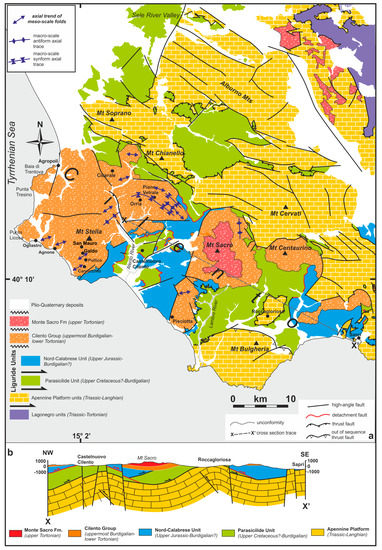
Figure 2.
(a) Geological map of Cilento; (b) geological cross-section (modified after [8]).
In the Pliocene–Pleistocene time, the crustal shortening produced an out-of-sequence thrusting that involved the tectonic prism, including the wedge-top basin deposits [34,35,36,37]. From the upper part of the Early Pleistocene, the orogenic chain was affected by the post-orogenic extension, starting from the Tyrrhenian side and migrating to the East, with the formation of several intramontane basins and coastal plains, including the Campania Plain, where extensive back-arc volcanism occurred [38].
2.2. The Cilento Group
2.2.1. Stratigraphy
The wedge-top basin deposits of CG comprise large exposure of turbiditic sediments with ages ranging from the uppermost Burdigalian to the lowermost Tortonian [6,8,32]. It presents thicknesses ranging from 1200 to 2400 m and crops out extensively in the Cilento area (Figure 2). Here, this coarsening-upward mega-sequence unconformably covers the LAC units and, in turn, is unconformably covered by the Monte Sacro Fm (Castelvetere Group; [30]) of the upper Tortonian–lower Messinian age. The sedimentary facies associations of the CG suggest a paleoenvironment characterized by submarine fan successions made of turbidite sequences [39,40] formed by sediment gravity flows [41,42,43,44,45]. In the northwestern Cilento area, the CG comprises different turbidite depositional systems grouped into two sedimentary units: the Pollica and San Mauro Fms.
The Pollica Fm (Figure 3), ~800 m thick [6], is characterized, at the base, by thin-bedded shaly fine-grained arenaceous distal turbidites (Cannicchio Mb), followed by more proximal turbidites consisting of coarse-grained sandstones locally interbedded with conglomerates [46]. The Cannicchio Mb is characterized by regular and laterally continuous bedding, as well as the presence of thin hemipelagic intercalations. These features are typical of the basin plain thin-bedded turbidites [47] or lobe fringe [46]. The remaining part of Pollica Fm sediments has been deposited in a transitional and/or marginal area at the distributary channels and the suprafan lobes [48] or at the middle-outer fan sequences [49,50]. The base of the strata is often erosional, and chaotic levels, which are associated with intraformational landslides, are frequent [46].
The San Mauro Fm (Figure 3), ~1600 m thick [6], was formed, from bottom to top, by a thick sedimentary succession consisting of pelitic–arenaceous and arenaceous–pelitic layers with frequent carbonate intercalations, even in megabeds. In the higher sections, there are still intervals of sandy and muddy sediments, but there is an increase in conglomerate–sandstone and conglomerate fractions. The vertical evolution of the sedimentary facies highlights progressively more proximal features, showing a progradational sequence of the thickening and coarsening-up type [51], passing from outer fan deposits (fan fringe and depositional lobes) to inner fan deposits (channelized deposits and mouth and of channel embankment). The sedimentary succession also includes two carbonate–clastic megabeds (“Fogliarina” layers), respectively ~65 and ~35 m thick, and others of a lower thickness (from 10 m to 50 cm), exposed in the lower part of the sequence. A thick conglomerate–sandstone portion caps the succession [52].
In the southeastern sector (from Pisciotta to Mt Sacro and Mt Centaurino, Figure 2a), the sedimentary facies of both formations become coarser with the dominance of conglomerates (Torrente Bruca facies of [18]), consisting of a few tens of meters of thinly bedded sandstones and micaceous siltites followed by an arenaceous–conglomeratic succession with frequent thick beds of rudites made of crystalline clasts and frequently eroded clay balls and chips, enclosed in an arenaceous matrix. Some marly beds and megabeds are present.
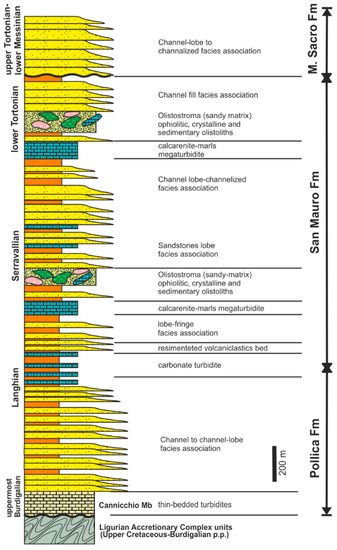
Figure 3.
Schematic stratigraphic log of the Cilento Group succession (modified after [53]).
2.2.2. Detrital Mode Evolution and Clastic Sources
CG sandstones are quartzolithic, volcanolithic and quartzofeldspathic [54]. In addition, the upper part (San Mauro Fm) contains numerous calcarenites and marly megabeds and some olistostromes with thicknesses ranging from a few tens to hundreds of meters. Plutonic, metamorphic and volcanic debris is found in the upper part of the Pollica Fm and the lower part of the San Mauro Fm. The latter deposits include abundant felsic calc-alkaline clasts, including rhyodacites and rhyolites [54].
The Miocene sandstones show a detrital evolution (Figure 4a), indicating a recycled orogen provenance related to the emplacement of CPT and LAC thrust sheets. In contrast, volcaniclastic sandstones in the median part of the CG (Figure 4a) show a magmatic arc provenance, such as the synchronous orogenic volcanism that occurred in the Sardinia block and Tyrrhenian basin [38,55]. The debris deriving from the LAC appears only in the upper-middle part of the CG (Figure 3 and Figure 4a), consisting of sandstones and olistostromes of pillow lavas and gabbros (Mt Centaurino, Figure 2a) and varicolored argillites and radiolarites (Mt Sacro, Figure 2a). However, the detrital mode evolution of the LAC quartzolithic sandstones (Figure 4a) is also related to the erosion of the CPT rocks with an andesitic volcano-lithic supply [54,56]. On the contrary, carbonate–clastic mega layers of “Fogliarina” [22,57] are well distinguished by large volumes of calcareous sands and muds, likely deriving from the orogenic deformation of Apennine Platform carbonates located to the east [54,58,59].
Recently, ref. [60] analyzed the fine-grained portion of the CG to determine paleoweathering, provenance and recycling information. The Authors state that the source area primarily comprises felsic rocks with a smaller number of mafic rocks, mostly corresponding to an upper crust composition evidenced by the Ni-La*4-V ternary plot (Figure 4b). Furthermore, the Chemical Index of Alteration (CIA) estimations suggest that moderate chemical paleoweathering processes accompanied the erosion. Finally, the analyzed sediments indicate poor sorting and rapid deposition.
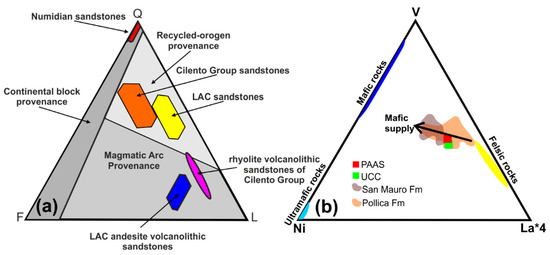
Figure 4.
(a) QFL triangular plot, showing detrital mode evolution of the CG, LAC and Numidian sandstones of the southern Apennines. Data sources [54,56,61]. (b) Provenance plot based on the V-Ni-La*4 relationships, showing fields representative of felsic, mafic and ultramafic rocks plotted separately. Modified after [60].
2.2.3. Deformation
The CG succession recorded the deformation stage that affected the orogenic chain in the lower Pliocene [36,37]. The deep structure of the Cilento area is defined by some out-of-sequence ramp-dominated blind and emerged thrust faults that formed the tectonic windows of Castel Nuovo Cilento and Roccagloriosa (Figure 2b; [8]) and the overthrusting of Mt Bulgheria onto the LAC ([62]; Figure 2a). The CG deposits host several structures, including thrust faults and folds, indicating a roughly NW–SE shortening and a vergence toward the SE; however, in the Orria–Piano Vetrale area (Figure 2a), an SW-verging overturned synclinal occurs [63].
Generally, the mesoscale folds are tight to open with a kink shape, such as in the Cannicchio Mb (Figure 5a) and the middle-upper part of the Pollica Fm (Figure 5c). Brittle shortening structures appear as pre-buckle thrust (Figure 5b) and thrust faults (Figure 5d–f) with centimetric-to-metric displacements and associated drag folds.
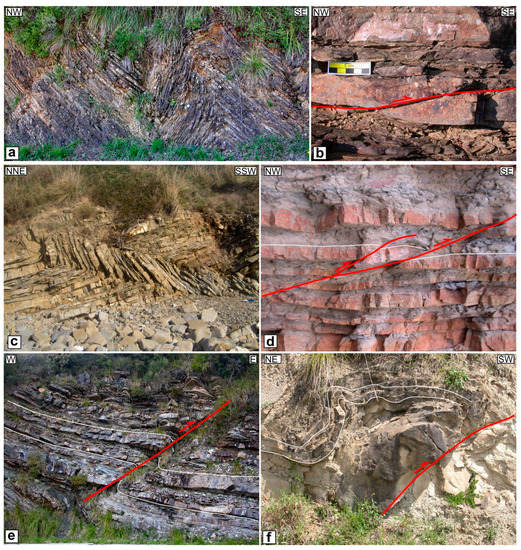
Figure 5.
Examples of deformation of the CG deposits. Cannicchio Mb: (a) kink folds (Cannicchio); (b) pre-buckle thrust (Cannicchio). Pollica Fm: (c) overturned kink folds (Agnone locality); (d) thrust verging to SE (Punta Licosa). San Mauro Fm: (e) thrust verging to E; (f) thrust and related folds verging to SW (Piano Vetrale).
3. Materials and Methods
For the assessment of turbidity paleocurrent directions, 74 different locations in Cilento were analyzed, spanning from the southern Pisciotta–Mt Sacro ridge to the northern town of Agropoli (Figure 2a), resulting in the collection of a total of 338 paleoflow directions. An average of 4–5 paleocurrent indicators per site were measured, with data distinguished according to their formations. As the succession was heavily deformed, especially in the lower part, for every paleocurrent orientation, the bedding attitude was recorded to allow the retro-deformation of the paleocurrent lineation, restoring the bedding in the horizontal attitude, assuming that the original paleocurrent plunge, which is lesser or equal to the turbidite bed dip angle, measures a few degrees. The retro-deformation of the paleocurrent and plotting of bedding orientation data was performed using the software TectonicsFP© 1.7.9 [64]. Subsequently, the retro-deformed data were analyzed as rose diagrams for the final evaluation of the mean azimuth. Finally, paleocurrent lineations were plotted in a geological map of Cilento as arrows for each site, according to their original turbidity paleocurrent directions.
4. Results
4.1. Field Observations
Various paleocurrent indicators [65,66] were identified in the field (Figure 6 and Figure 7). These structures mainly consist of flute casts (Figure 6e,f and Figure 7a) and, to a lesser extent, groove casts (Figure 7b), flame structures (Figure 7c) and ripple marks (Figure 7d). Most of these structures were preserved within the more resistant lithologies, such as sandstones, especially those with larger thicknesses. Flute casts are structures formed by a paleocurrent flow that erodes and widens downstream from a specific point known as the “nose”. These structures suddenly deepen before gradually becoming shallower toward their end [66]. Flute casts form when a substrate erodes and is then typically filled with sand. These marks are recognizable as indentations on the bottom of beds. The quality of the paleocurrent indicators depends not only on the movement of the sedimentary material but also on the depositional dynamics; in fact, during the deposition of the turbidity currents, the more energetic ones dig furrows at the bottom. However, in several cases, such as those shown in Figure 6e,f and Figure 7e,f, the presence of ichnofossils (Thalassinoides and Helminthorhaphe [67]) has perturbed the layers, partially or fully eliminating the footprints of paleocurrents; as a result, several outcrops were not considered reliable and therefore prudently discarded or cautiously analyzed. In some cases, flame structures (Figure 7c) and ripple marks (Figure 7d) were used to evaluate the paleocurrent direction as the line orthogonal to the lineation that these structures form when crosscutting the bed surface. The best-preserved turbidity paleocurrents were observed in the northern sector of the Cilento due to the occurrence of fine-grained sediments compared to the southern part, where Pollica and San Mauro Fms show a dominance of conglomerates (Torrente Bruca facies).
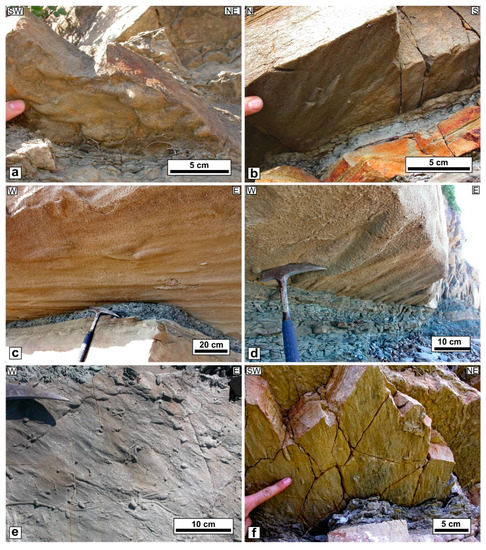
Figure 6.
Examples of paleocurrent indicators. Pollica Fm (Punta Licosa): (a) bulbous and (b) spindle flute casts sensu [66]. Flute casts in San Mauro Fm: (c) Punta Tresino and (d) Baia di Trentova. (e,f) Flute casts and ichnofossils (Thalassinoides) in San Mauro Fm (Baia di Trentova).
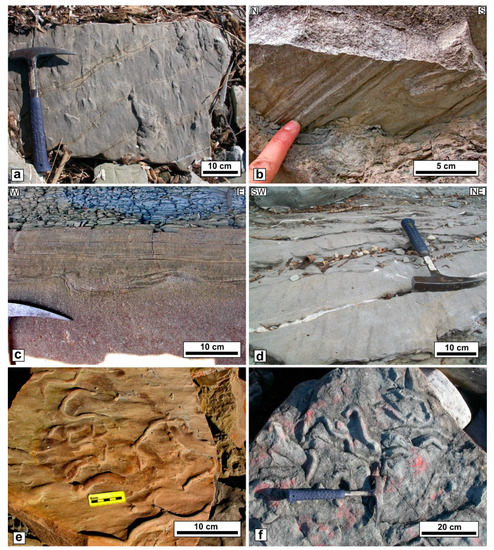
Figure 7.
Examples of paleocurrent indicators. (a) Flute casts in the San Mauro Fm (Baia di Trentova). (b) Groove cast indicators in the San Mauro Fm (Galdo). (c) Flame structure in the San Mauro Formation (Punta Tresino). (d) Ripple marks in the San Mauro Fm (Agropoli). (e) Ichnofossils (Helminthorhaphe) superposed on flute clasts in the San Mauro Fm (Punta Tresino). (f) Ichnofossils (Helminthorhaphe) in the San Mauro Fm (Agropoli).
4.2. Restored Paleocurrent Lineations
For each site, the mean trends of the restored paleocurrent directions have been calculated and plotted as arrows in the geological map (Figure 8a). It is worth noting that the paleocurrent directions form a generally consistent pattern where parallel lineations are dominant in some areas, and orthogonal sets occur in others. Furthermore, in several places, opposite trends are present.
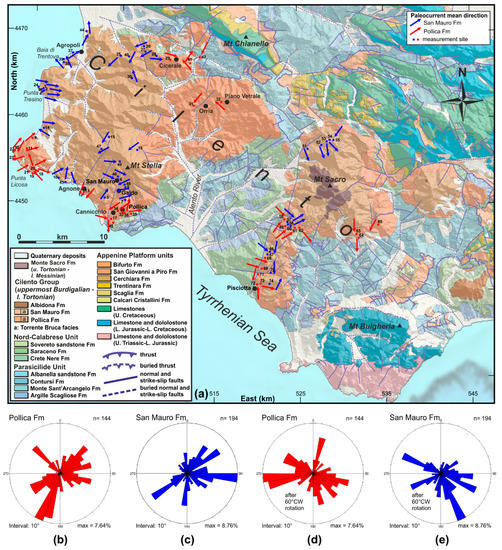
Figure 8.
(a) Geological map of Cilento (modified after [30]) with oriented indicators of the mean paleocurrents. Rose diagrams of the directions of the restored paleocurrents: (b) Pollica Fm; (c) San Mauro Fm. After 60° clockwise (CW) rotation: (d) Pollica Fm; (e) San Mauro Fm.
We grouped all restored paleocurrent lineations according to the hosting rock nomenclature (formations). The rose diagram of Pollica Fm (Figure 8b) indicates the main preferred trends toward the SSW and NE and, secondarily, the SW, ESE and NW.
The rose diagram of San Mauro Fm (Figure 8c) shows the main directions toward the E, S, SW and NE. To restore the flow directions with the correct orientation in the uppermost Burdigalian–lower Tortonian period (age of the CG), we must consider that the Cilento area rotated counterclockwise at an average angle of 60° from the Miocene, according to the studies on magnetic lineations in the carbonates of Alburno and Bulgheria Mts [68] located nearby the study area (Figure 2a). Therefore, we rotated all the data clockwise around a vertical axis of 60°. The resulting rose diagrams (Figure 8d,e) indicate that the restored turbiditic flows were directed mainly toward the WSW, NW, SE, SSE and NNE for the Pollica Fm and the SSE, ESE, WSW and WNW for the San Mauro Fm.
5. Discussion
The paleocurrent analysis performed on the CG deposits provides some valuable information that is helpful in reconstructing the geometry of the wedge-top basin formed in the early stages of the southern Apennine orogeny. As previously stated, the paleocurrent pattern exhibits large heterogeneity. In neighboring areas, the turbidity paleocurrents are typically nearly parallel with consistent flow directions. However, in other areas, they form orthogonal sets or show opposite flow directions, a common feature in confined turbidite settings [69,70], such as in structurally controlled elongated basins like wedge-top basins [3,71]. Based on the paleocurrent analyses for the two formations, preferred orientations have been observed. Generally, both formations show different preferred flow directions, suggesting a non-uniform basin architecture made of the superposition of several turbidite lobes [47,53,54,72]. We suggest that the well-represented restored flow directions toward the S, SSE and NNE (Figure 8d,e) are related to the turbidites that flow parallel to the depocenter axis, with a mean N-S direction, accordingly with other paleogeographic reconstructions, e.g., [72]. It is possible to interpret other preferred directions as being at a high angle, converging toward the depocenter axis.
The detrital evolution of the CG deposits indicates a mixed provenance from the CPT, LAC and Apennine Platform, as well as the volcaniclastics from the Miocene synorogenic volcanic arc located westward of the Cilento Basin [56]. It is worth noting as the Numidian sandstones, extensively occurring in the Apennine Platform foredeep deposits and Lagonegro–Molise Basin succession [26,30] and coeval with the Pollica Fm, show a detrital evolution (Figure 4a), indicating a continental block provenance, being very different from CG sandstones, which are characterized by a recycling provenance. Based on this feature, it appears that during the uppermost Burdigalian–Langhian, the Cilento Basin was separated from the Apennine Platform foredeep basin and that any sediment material came from the recycling of the LAC and CPT. Considering the paleocurrent data and clastic provenance, we suggest a simplified model of the CG basin (Figure 9) defined by a linear depocenter with a roughly N-S trending axis and clastic supply mainly from the LAC and Apennine Platform carbonates (to the E), LAC and CPT (to the W) and volcaniclastics from a volcanic arc located to the west, likely belonging to the Sardinia block [38].
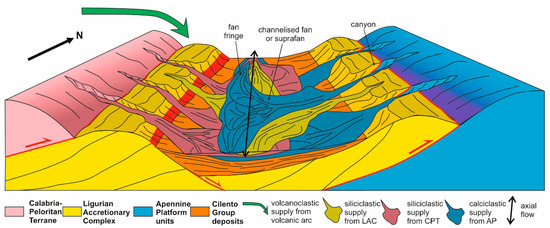
Figure 9.
Three-dimensional model of the Cilento Group wedge-top basin.
The petrography of the clastic content of the CG indicates a detrital evolution from metamorphic-bearing sandstones, including abundant volcanic and sedimentary detritus in the lower part, to plutoniclastic-bearing sandstones in the upper part of the succession [56]. This abrupt change is consistent with the first clastic recycling from the LAC itself and an unroofing of the CPT, with erosion shifting from the uppermost rocks, such as the sedimentary cover, to the deeper plutonic rocks over time.
According to [8], the formation of the CG wedge-top basin can be attributed to the extensional collapse of the LAC. This event likely occurred due to the buttressing of the over-thickened orogenic prism against the Apennine Platform in the uppermost Burdigalian. Low-angle extensional detachments associated with synorogenic extension favored the development of accommodation space in wedge-top basin depocentres. This hypothesis has been supported by [60], the Authors of which analyzed the thermal maturity of organic and inorganic fractions of fine sediments of the CG. Their results indicate two rapid sediment accumulation phases during the CG deposition. The first has an age ranging between 16 and 13 Ma (uppermost Burdigalian–Langhian), and the second has an age ranging between 6 and 3 Ma (upper Messinian–Pliocene). A lower accumulation rate separated these two phases. The high accumulation rate of 2.7 mm/yr for the first stage of CG sedimentation is consistent with rapid subsidence, such as that occurring in an extensional rather than a compressional setting [60]. On the other hand, the lower rate (1.1 mm/yr) of the second phase could be associated with the out-of-sequence deformation that affected the CG deposits in the lower Pliocene, which featured a renewed orogenic thickening due to the diffuse thrust faults and folds. This possibly includes the regional SW-verging recumbent fold in the Orria–Piano Vetrale area (Figure 2a; [39]), probably associated with the back thrusting of the Apennine Platform carbonates onto the CG deposits.
To better explain the sedimentary evolution of the Cilento Basin within the framework of the orogenic evolution of the southern Apennines, we illustrate in the cartoons of Figure 10 the first stages of the Apennine construction from Oligocene to Tortonian. In the Oligocene–Aquitanian (Figure 10a), the ophiolitic successions of the Ligurian Ocean were subducted and added to the subduction channel [73]. In this period, the easternmost sector of the Ligurian Ocean (Nord-Calabrese, Parasicilide and Sicilide units) experienced a foredeep stage. In the early Burdigalian (Figure 10b), the Ligurian successions were piled up by frontal accretion forming the LAC, subsequently (Figure 10c) overthrusted onto the Apennine Platform domain, the latter forming a buttress that caused the over-thickening of the LAC followed by a collapse (Figure 10d). On the extended orogenic prism, the Cilento Basin formed and was first filled by the Pollica Fm sediments (Figure 10d) and subsequently by San Mauro Fm sediments (Figure 10e). The latter included a calciclastic supply (“Fogliarina” megabeds) originating from the Apennine Platform units that, in the Langhian–Serravallian, were included in the orogenic prism. Finally, in the upper Tortonian–lower Messinian (Figure 10f), the whole chain was covered by the wedge-top basin Castelvetere Group clastic deposits, including the Monte Sacro Fm in Cilento and Gorgoglione and Oriolo Fms in the easternmost sectors overlying the Lagonegro–Molise Basin thrust sheets. In the Calabria sector, to the south, the coeval clastic deposits of the Amantea Group were deposited during the opening of the Tyrrhenian back-arc basin [74].
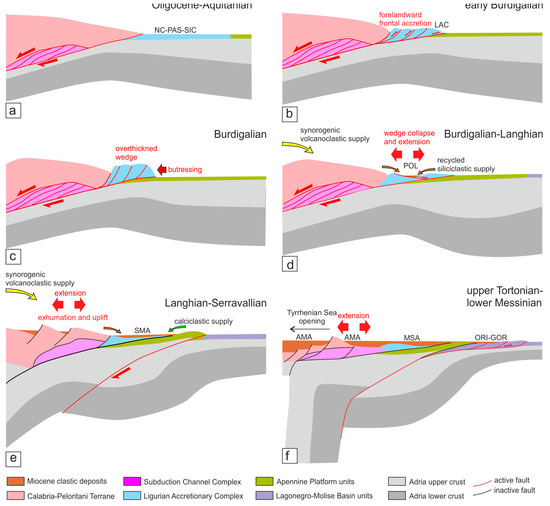
Figure 10.
(a–f) Tectonic and sedimentary evolution of the Ligurian Accretionary Complex from the Oligocene to lower Messinian. NCA: Nord-Calabrese Domain; PAS: Parasicilide Domain; SIC: Sicilide Domain; LAC: Ligurian Accretionary Complex; POL: Pollica Fm; SMA: San Mauro Fm; AMA: Amantea Group Basin; MSA: Monte Sacro Fm; ORI: Oriolo Fm; GOR: Gorgoglione Fm.
Finally, Figure 11 shows the Langhian–Serravallian paleogeographic maps when the Cilento Basin formed on top of the early Apennine orogenic chain. In the Langhian (Figure 11a), the Cilento Basin was fed by different clastic sources, including the CPT and synorogenic volcanoes located in the W and SW, and the LAC both from the W and E, accordingly to the paleocurrent preferred directions of the Pollica Fm turbidites. Synchronously, the whole western-central Mediterranean area was the location of the Numidian sandstone deposition, beginning from the Rif and Betic chains and passing to the Kabylides, Sicilian Maghrebides and finally to the Lagonegro–Molise Basin, and the foredeep basin of the Apennine Platform [75]. In the Serravallian (Figure 11b), the Cilento Basin was fed again by the CPT, LAC and synorogenic volcanoes with the addition of sediments derived from a source located to the E of calciclastics, originating from the erosion of the Apennine Platform thrust sheets that were forming in that period [32]. On the map, the synchronous basin of the Amantea Group is shown. It was forming along the western side of the CPT, being related to the stretching of the chain and anticipating the opening of the Tyrrhenian back-arc basin [74].
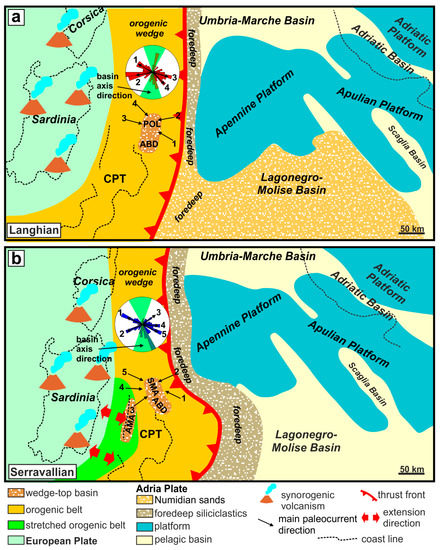
Figure 11.
Paleogeographic maps of the central sector of the Mediterranean area in (a) Langhian and (b) Serravallian. Numbers in the rose diagrams and paleogeographic maps indicate the corresponding main paleocurrent directions.
6. Conclusions
We analyzed the turbidity paleocurrents of the uppermost Burdigalian–lowermost Tortonian Cilento Group in the southern Apennines (Italy). This turbiditic succession consists of sandstones, conglomerates, marls and pelites grouped in the uppermost Burdigalian–Langhian Pollica Fm and the Serravallian–lowermost Tortonian San Mauro Fm. The CG succession deposited in the first wedge-top basin of the southern Apennine orogeny formed in an extensional environment resulting from the wedge collapse during the overthrusting onto the western margin of the Apennine Platform.
We analyzed flute and groove casts, flame structures and ripple marks. Due to the intense deformation of the succession, we reconstructed the original attitude, restoring the horizontal beds hosting the paleocurrent features. We collected 338 measurements from 74 sites across the whole of Cilento. The results indicate that turbidity paleocurrents form a complex spatial pattern, with some areas having parallel and concordant directions and others having opposite or orthogonal flow directions. This feature is common in tectonic-controlled depressions such as wedge-top basins. When analyzed as a whole, the reconstructed paleocurrent flows show some preferred directions. Paleocurrents in the Pollica Fm, restored to the Langhian paleogeography, are characterized by preferred directions toward the W-NW and E to SSE. Paleocurrents in the San Mauro indicate the same previous directions with a dominance of the SSE azimuth about parallel to the basin axis.
According to the detrital evolutions, paleocurrent directions and paleogeographic reconstructions, the sources of the recycled siliciclastic sediments were the CPT, located to the W, and the LAC, which hosted the Cilento Basin. The volcaniclastic source was the synchronous volcanic arc located in the Sardinia block. Finally, the carbonate supply that formed the “Fogliarina” megabeds in the San Mauro Fm originated from the Apennine Platform units located to the E, recording the development of the first tectonic piling up of the Apennine carbonates in the Serravallian.
Author Contributions
Conceptualization, S.C. and S.V.; methodology, S.C. and S.V.; software, L.L.S., M.M. and S.V.; validation, S.C. and S.V.; formal analysis, L.L.S., M.M., S.C. and S.V.; investigation, L.L.S., M.M., S.C. and S.V.; resources, S.V.; data curation, J.N., L.L.S., M.M., S.C. and S.V.; writing—original draft preparation, J.N., M.M., S.C. and S.V.; writing—review and editing, M.M., S.C. and S.V.; visualization, M.M. and S.V.; supervision, S.C. and S.V.; project administration, S.C. and S.V.; funding acquisition, S.C. and S.V. All authors have read and agreed to the published version of the manuscript.
Funding
This research received no external funding.
Data Availability Statement
Publicly available datasets were analyzed in this study. The data can be found here: https://osf.io/ngk2c/?view_only=937a6ec4863b43b49bfa9f4c842d77b1 (accessed on 20 June 2023).
Acknowledgments
We thank the assistant editor and the three anonymous reviewers for their useful suggestions, which greatly improved this paper.
Conflicts of Interest
The authors declare no conflict of interest.
References
- DeCelles, P.G. Foreland basin systems revisited: Variations in response to tectonic settings. In Tectonics of Sedimentary Basins: Recent Advances; Busby, C., Azor Pérez, A., Eds.; Blackwell Publishing Ltd.: Hoboken, NJ, USA, 2012; pp. 405–426. [Google Scholar]
- Dickinson, W.R. Plate tectonics and sedimentation. In Tectonics and Sedimentation; Dickinson, W.R., Ed.; SEPM Specia Publication: Tulsa, OK, USA, 1974; Volume 22, pp. 1–27. [Google Scholar]
- Tinterri, R.; Tagliaferri, A. The syntectonic evolution of foredeep turbidites related to basin segmentation: Facies response to the increase in tectonic confinement (Marnoso-arenacea Formation, Miocene, Northern Apennines, Italy). Mar. Pet. Geol. 2015, 67, 81–110. [Google Scholar] [CrossRef]
- Pascucci, V.; Costantini, A.; Martini, P.; Dringoli, R. Tectono-sedimentary analysis of a complex, extensional, Neogene basin formed on thrust-faulted, Northern Apennines hinterland: Radicofani Basin, Italy. Sediment. Geol. 2006, 183, 71–97. [Google Scholar] [CrossRef]
- Vitale, S.; Ciarcia, S. Tectono-stratigraphic and kinematic evolution of the southern Apennines/Calabria–Peloritani Terrane system (Italy). Tectonophysics 2013, 583, 164–182. [Google Scholar]
- Amore, F.O.; Bonardi, G.; Ciampo, G.; De Capoa, P.; Perrone, V.; Sgrosso, I. Relazioni tra Flysch interni e domini Appenninici: Reinterpretazione delle formazioni di Pollica, San Mauro e Albidona e il problema dell’evoluzione inframiocenica delle zone esterne Appenniniche. Mem. Soc. Geol. Ital. 1988, 41, 285–297. [Google Scholar]
- Mazzoli, S.; D’errico, M.; Aldega, L.; Corrado, S.; Invernizzi, C.; Shiner, P.; Zattin, M. Tectonic burial and “young”(<10 Ma) exhumation in the southern Apennines fold-and-thrust belt (Italy). Geology 2008, 36, 243–246. [Google Scholar]
- Vitale, S.; Ciarcia, S.; Mazzoli, S.; Zaghloul, M.N. Tectonic evolution of the ‘Liguride’accretionary wedge in the Cilento area, southern Italy: A record of early Apennine geodynamics. J. Geodyn. 2011, 51, 25–36. [Google Scholar] [CrossRef]
- Ciarcia, S.; Mazzoli, S.; Vitale, S.; Zattin, M. On the tectonic evolution of the Ligurian accretionary complex in southern Italy. Bulletin 2011, 124, 463–483. [Google Scholar] [CrossRef]
- ISPRA. Carta Geologica d’Italia alla Scala 1:50.000, Foglio 506 “Sant’Arcangelo”. Available online: https://www.isprambiente.gov.it/Media/carg/506_SANT_ARCANGELO/Foglio.html (accessed on 1 June 2023).
- Bonardi, G.; Amore, F.O.; Ciampo, G.; De Capoa, P.; Miconnet, P.; Perrone, V. Il complesso Liguride Auct.: Stato delle conoscenze e problemi aperti dulla sur evoluzione pre-Appenninica ed i suoli rapporti con l’Arco Calabro. Mem. Soc. Geol. Ital. 1988, 41, 17–35. [Google Scholar]
- Russo, M.; Zuppetta, A.; Guida, A. Alcune precisazioni stratigrafiche sul Flysch del Cilento (Appennino meridionale). Boll. Soc. Geol. Ital. 1995, 114, 353–359. [Google Scholar]
- ISPRA. Carta Geologica d’Italia alla Scala 1:50.000, Foglio 503 “Vallo della Lucania”. Available online: http://www.isprambiente.gov.it/Media/carg/503_VALLO/Foglio.html (accessed on 1 June 2023).
- ISPRA. Carta Geologica d’Italia alla Scala 1:50.000, Foglio 504 “Sala Consilina”. Available online: http://www.isprambiente.gov.it/Media/carg/504_SALA_CONSILINA/Foglio.html (accessed on 1 June 2023).
- ISPRA. Carta Geologica d’Italia alla Scala 1:50.000, Foglio 502 “Agropoli”. Available online: http://www.isprambiente.gov.it/Media/carg/502_AGROPOLI/Foglio.html (accessed on 1 June 2023).
- ISPRA. Carta Geologica d’Italia alla Scala 1:50.000, Foglio 520 “Sapri”. Available online: http://www.isprambiente.gov.it/Media/carg/520_SAPRI/Foglio.html (accessed on 1 June 2023).
- ISPRA. Carta Geologica d’Italia alla Scala 1:50.000, Foglio 519 “Capo Palinuro”. Available online: http://www.isprambiente.gov.it/Media/carg/519_CAPO_PALINURO/Foglio.html (accessed on 1 June 2023).
- Guida, D.; Iaccarino, G.; Perrone, V. Nuovi dati sulla successione del Flysch del Cilento nell’area di Monte Centaurino: Relazioni tra unita litostratigrafiche, unita littotecniche e principali sistemi franosi. Mem. Soc. Geol. Ital. 1988, 41, 299–310. [Google Scholar]
- Cesarano, M.A.; Pierantoni, P.P.; Turco, E.U. Structural analysis of the Albidona Formation in the Alessandria del Carretto-Plataci area (Calabro-Lucanian Apennines, southern Italy). Boll. Soc. Geol. Ital. 2002, 1, 669–676. [Google Scholar]
- Ciarcia, S.; Vitale, S.; Di Staso, A.; Iannace, A.; Mazzoli, S.; Torre, M. Stratigraphy and tectonics of an Internal Unit of the southern Apennines: Implications for the geodynamic evolution of the peri-Tyrrhenian mountain belt. Terra Nova 2009, 21, 88–96. [Google Scholar] [CrossRef]
- Vitale, S.; Ciarcia, S.; Mazzoli, S.; Iannace, A.; Torre, M. Structural analysis of the ‘Internal’Units of Cilento, Italy: New constraints on the Miocene tectonic evolution of the southern Apennine accretionary wedge. C. R. Geosci. 2010, 342, 475–482. [Google Scholar] [CrossRef]
- Pescatore, T. Strutture sedimentarie nel Flysch del Cilento occidentale [Sedimentary structures in the western Cilento flysch]. Geol. Romana 1966, 5, 99–116. [Google Scholar]
- Cocco, E.; De Magistris, M.A.; De Pippo, T. Sedimentologia Del Flysch Del Cilento. I: Le Arenarie Di Serramezzana (Cilento, Apennino Meridionale). Geol Romana 1978, 17, 289–302. [Google Scholar]
- Faccenna, C.; Becker, T.W.; Lucente, F.P.; Jolivet, L.; Rossetti, F. History of subduction and back arc extension in the Central Mediterranean. Geophys. J. Int. 2001, 145, 809–820. [Google Scholar] [CrossRef]
- Carminati, E.; Lustrino, M.; Doglioni, C. Geodynamic evolution of the central and western Mediterranean: Tectonics vs. igneous petrology constraints. Tectonophysics 2012, 579, 173–192. [Google Scholar] [CrossRef]
- Vitale, S.; Ciarcia, S. The dismembering of the Adria platforms following the Late Cretaceous-Eocene abortive rift: A review of the tectono-stratigraphic record in the southern Apennines. Int. Geol. Rev. 2022, 64, 2866–2889. [Google Scholar] [CrossRef]
- Van Hinsbergen, D.J.; Torsvik, T.H.; Schmid, S.M.; Maţenco, L.C.; Maffione, M.; Vissers, R.L.; Gürer, D.; Spakman, W. Orogenic architecture of the Mediterranean region and kinematic reconstruction of its tectonic evolution since the Triassic. Gondwana Res. 2020, 81, 79–229. [Google Scholar]
- Patacca, E.; Sartori, R.; Scandone, P. Tyrrhenian basin and Apenninic arcs: Kinematic relations since Late Tortonian times. Mem. Soc. Geol. Ital. 1990, 45, 425–451. [Google Scholar]
- Patacca, E.; Scandone, P. Geology of the southern Apennines. Boll. Soc. Geol. Ital. 2007, 7, 75–119. [Google Scholar]
- Vitale, S.; Ciarcia, S. Tectono-stratigraphic setting of the Campania region (southern Italy). J. Maps 2018, 14, 9–21. [Google Scholar] [CrossRef]
- Scrocca, D. Southern Apennines: Structural setting and tectonic evolution. J. Virtual Explor. 2010, 36. [Google Scholar] [CrossRef]
- Vitale, S.; Ciarcia, S.; Tramparulo, F.D.A. Deformation and stratigraphic evolution of the Ligurian Accretionary Complex in the southern Apennines (Italy). J. Geodyn. 2013, 66, 120–133. [Google Scholar] [CrossRef]
- Bonardi, G.; Cavazza, W.; Perrone, V.; Rossi, S. Calabria-Peloritani terrane and northern Ionian sea. In Anatomy of an Orogen: The Apennines and Adjacent Mediterranean Basins; Springer: Dordrecht, The Netherlands, 2001; pp. 287–306. [Google Scholar]
- Vitale, S.; Prinzi, E.P.; Ciarcia, S.; Sabbatino, M.; Tramparulo, F.D.A.; Verazzo, G. Polyphase out-of-sequence thrusting and occurrence of marble detritus within the wedge-top basin deposits in the Mt. Massico (southern Apennines): Insights into the late Miocene tectonic evolution of the central Mediterranean. Int. J. Earth Sci. 2019, 108, 501–519. [Google Scholar] [CrossRef]
- Vitale, S.; Tramparulo, F.D.A.; Ciarcia, S.; Amore, F.O.; Prinzi, E.P.; Laiena, F. The northward tectonic transport in the southern Apennines: Examples from the Capri Island and western Sorrento Peninsula (Italy). Int. J. Earth Sci. 2017, 106, 97–113. [Google Scholar] [CrossRef]
- Vitale, S.; Prinzi, E.P.; Monda, M.; Tramparulo, F.D.A.; Ciarcia, S. Structural and stratigraphic setting of Campagna and Giffoni tectonic windows: New insights on the orogenic evolution of the Southern Apennines (Italy). Geosciences 2020, 10, 405. [Google Scholar] [CrossRef]
- Vitale, S.; Prinzi, E.P.; Tramparulo, F.D.A.; De Paola, C.; Di Maio, R.; Piegari, E.; Sabbatino, M.; Natale, J.; Notaro, P.; Ciarcia, S. Late Miocene-early Pliocene out-of-sequence thrusting in the southern Apennines (Italy). Geosciences 2020, 10, 301. [Google Scholar] [CrossRef]
- Savelli, C. Time–space distribution of magmatic activity in the western Mediterranean and peripheral orogens during the past 30 Ma (a stimulus to geodynamic considerations). J. Geodyn. 2002, 34, 99–126. [Google Scholar] [CrossRef]
- Hansen, K.; Bouma, A.H. Sedimentology of Some Flysch Deposits. A Graphic Approach to Facies Interpretation; Elsevier Publishing Company: Amsterdam, NY, USA, 1962; Volume 61. [Google Scholar]
- Bouma, A.H.; Normark, W.R.; Barnes, N.E. Submarine Fans and Related Turbidite Systems; Springer: New York, NY, USA, 1985. [Google Scholar]
- Lowe, D.R. Sediment gravity flows: Their classification and some problems of application to natural flows and deposits. In Geology of Continental Slopes; SEPM Special Publication: Tulsa, OK, USA, 1979; pp. 75–82. [Google Scholar]
- Lowe, D.R. Sediment gravity flows; II, Depositional models with special reference to the deposits of high-density turbidity currents. J. Sediment. Res. 1982, 52, 279–297. [Google Scholar]
- Walker, R.G.; Mutti, E. Part IV. Turbidite Facies and Facies Associations; SEPM Soc for Sed Geol: Tulsa, OK, USA, 1973. [Google Scholar]
- Walker, R.G. Deep-water sandstone facies and ancient submarine fans: Models for exploration for stratigraphic traps. AAPG Bull. 1978, 62, 932–966. [Google Scholar]
- Mutti, E.; Bernoulli, D.; Lucchi, F.R.; Tinterri, R. Turbidites and turbidity currents from Alpine ‘flysch’to the exploration of continental margins. Sedimentology 2009, 56, 267–318. [Google Scholar] [CrossRef]
- Critelli, S.; Le Pera, E. Litostratigrafia e composizione della Formazione di Pollica (Gruppo del Cilento, Appennino meridionale). Boll. Soc. Geol. Ital. 1990, 109, 511–536. [Google Scholar]
- Mutti, E. Distinctive thin-bedded turbidite facies and related depositional environments in the Eocene Hecho Group (South-central Pyrenees, Spain). In Deep-Water Turbidite Systems; The International Association of Sedimentologists: Ghent, Belgium, 1991; pp. 181–205. [Google Scholar]
- Normark, W.R. Growth patterns of deep-sea fans. AAPG Bull. 1970, 54, 2170–2195. [Google Scholar]
- Mutti, E.; Lucchi, F. Le torbiditi dell’Appennino Settentrionale: Introduzione all’analisi di facies. Mem. Soc. Geol. Ital. 1972, 11, 161–199. [Google Scholar]
- Mutti, E.; Ricci, L.F. The significance of certain sequential units in turbidite series. Bull. Soc. Geol. Fr. 1975, 16, 577–582. [Google Scholar]
- Ricci-Lucchi, F. Depositional cycles in two turbidite formations of northern Apennines. J. Sediment. Res. 1975, 45, 3–43. [Google Scholar] [CrossRef]
- Critelli, S. Petrologia delle areniti della formazione di San Mauro (Eocene superiore-Oligocene superiore, Bacino del Cilento), Appennino meridionale. Mem. Soc. Geol. Ital. 1987, 38, 601–619. [Google Scholar]
- Critelli, S. The interplay of lithospheric flexure and thrust accomodation in forming stratigraphic sequences in the southern Apennines foreland basin system, Italy. Rend. Lincei 1999, 10, 257–326. [Google Scholar]
- Critelli, S.; Le Pera, E. Detrital modes and provenance of Miocene sandstones and modern sands to the Southern Apennines thrust-top basins (Italy). J. Sediment. Res. 1994, 64, 824–835. [Google Scholar] [CrossRef]
- Cavazza, W. Detrital modes and provenance of the Stilo-Capo d’Orlando Formation (Miocene), southern Italy. Sedimentology 1989, 36, 1077–1090. [Google Scholar] [CrossRef]
- Critelli, S. Evoluzione delle mode detritiche delle successioni arenitiche terziarie dell’Appennino meridionale. Mem. Soc. Geol. Ital. 1991, 47, 55–93. [Google Scholar]
- Cocco, E.; Pescatore, T. Scivolamenti gravitativi (olistostromi) nel Flysch del Cilento (Campania). Boll. Soc. Nat. Napoli 1968, 77, 51–91. [Google Scholar]
- Cieszkowski, M.; Oszczypko, N.; Pescatore, T.; Slaczka, A.; Senatore, M.R.; Valente, A. Megatorbiditi calcareo-marnose nelle successioni flyscioidi dell’Appennino meridionale (Cilento, Italia) e dei Carpazi settentrionali (Polonia). Boll. Soc. Geol. Ital. 1995, 114, 66–88. [Google Scholar]
- Colella, A.; Zuffa, G. Megastrati carbonatici e silicoclastici della Formazione di Albidona (Miocene, Appennino meridionale): Implicazioni paleogeografiche. Mem. Soc. Geol. Ital. 1988, 41, 791–807. [Google Scholar]
- Corrado, S.; Aldega, L.; Perri, F.; Critelli, S.; Muto, F.; Schito, A.; Tripodi, V. Detecting syn-orogenic extension and sediment provenance of the Cilento wedge top basin (southern Apennines, Italy): Mineralogy and geochemistry of fine-grained sediments and petrography of dispersed organic matter. Tectonophysics 2019, 750, 404–418. [Google Scholar] [CrossRef]
- Critelli, S. Sandstone detrital modes in the Paleogene Liguride Complex, accretionary wedge of the southern Apennines (Italy). J. Sediment. Res. 1993, 63, 464–476. [Google Scholar]
- Tozzi, M.; Menconi, A.; Sciamanna, S. Studio strutturale del Monte Bulgheria (Cilento meridionale) e sue implicazioni per la tettogenesi dell’Appennino Campano. Boll. Soc. Geol. Ital. 1996, 115, 249–278. [Google Scholar]
- Zuppetta, A.; Mazzoli, S. Deformation history of a synorogenic sedimentary wedge, northern Cilento area, southern Apennines thrust and fold belt, Italy. Geol. Soc. Am. Bull. 1997, 109, 698–708. [Google Scholar] [CrossRef]
- Reiter, F.; Acs, P. TectonicsFP ©1996–2023. Available online: https://github.com/freiter/TectonicsFP (accessed on 1 February 2023).
- Allen, J. Sedimentary Structures, Their Character and Physical Basis Volume 1; Elsevier: Amsterdam, The Netherlands, 1982. [Google Scholar]
- Peakall, J.; Best, J.; Baas, J.H.; Hodgson, D.M.; Clare, M.A.; Talling, P.J.; Dorrell, R.M.; Lee, D.R. An integrated process-based model of flutes and tool marks in deep-water environments: Implications for palaeohydraulics, the Bouma sequence and hybrid event beds. Sedimentology 2020, 67, 1601–1666. [Google Scholar] [CrossRef]
- Uchman, A. Taxonomy and palaeoecology of flysch trace fossils: The Marnoso-arenacea Formation and associated facies (Miocene, Northern Apennines, Italy). Beringeria 1995, 15, 1–115. [Google Scholar]
- Gattacceca, J.; Speranza, F. Paleomagnetism of Jurassic to Miocene sediments from the Apenninic carbonate platform (southern Apennines, Italy): Evidence for a 60° counterclockwise Miocene rotation. Earth Planet. Sci. Lett. 2002, 201, 19–34. [Google Scholar] [CrossRef]
- Sinclair, H.; Tomasso, M. Depositional evolution of confined turbidite basins. J. Sediment. Res. 2002, 72, 451–456. [Google Scholar] [CrossRef]
- Marini, M.; Felletti, F.; Milli, S.; Patacci, M. The thick-bedded tail of turbidite thickness distribution as a proxy for flow confinement: Examples from tertiary basins of central and northern Apennines (Italy). Sediment. Geol. 2016, 341, 96–118. [Google Scholar] [CrossRef]
- Milli, S.; Moscatelli, M.; Stanzione, O.; Falcini, F. Sedimentology and physical stratigraphy of the Messinian turbidite deposits of the Laga Basin (central Apennines, Italy). Boll. Soc. Geol. Ital. 2007, 126, 255. [Google Scholar]
- Critelli, S. Provenance of Mesozoic to Cenozoic circum-Mediterranean sandstones in relation to tectonic setting. Earth-Sci. Rev. 2018, 185, 624–648. [Google Scholar] [CrossRef]
- Vitale, S.; Ciarcia, S.; Fedele, L.; Tramparulo, F.D.A. The Ligurian oceanic successions in southern Italy: The key to decrypting the first orogenic stages of the southern Apennines-Calabria chain system. Tectonophysics 2019, 750, 243–261. [Google Scholar] [CrossRef]
- Mattei, M.; Speranza, F.; Argentieri, A.; Rossetti, F.; Sagnotti, L.; Funiciello, R. Extensional tectonics in the Amantea basin (Calabria, Italy): A comparison between structural and magnetic anisotropy data. Tectonophysics 1999, 307, 33–49. [Google Scholar] [CrossRef]
- Fornelli, A.; Micheletti, F.; Langone, A.; Perrone, V. First U–Pb detrital zircon ages from Numidian sandstones in Southern Apennines (Italy): Evidences of African provenance. Sediment. Geol. 2015, 320, 19–29. [Google Scholar] [CrossRef]
Disclaimer/Publisher’s Note: The statements, opinions and data contained in all publications are solely those of the individual author(s) and contributor(s) and not of MDPI and/or the editor(s). MDPI and/or the editor(s) disclaim responsibility for any injury to people or property resulting from any ideas, methods, instructions or products referred to in the content. |
© 2023 by the authors. Licensee MDPI, Basel, Switzerland. This article is an open access article distributed under the terms and conditions of the Creative Commons Attribution (CC BY) license (https://creativecommons.org/licenses/by/4.0/).